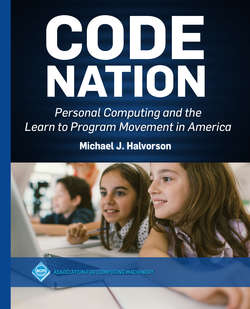Читать книгу Code Nation - Michael J. Halvorson - Страница 11
На сайте Литреса книга снята с продажи.
1.2Programminglearning languageLearning a Language
ОглавлениеBy Computer language the late 1960s, programming emerged from America’s research labs and government institutions to have a direct influence on universities, primary and secondary schools (K-12 in the U.S.), and the nation’s businesses. But what type of mental activity did programming entail? How should students take their first steps when learning to program a computer? In search of an analogy, some specialists suggested that learning to program was a bit like learning to read or speak in a Foreign language foreign language. Utilizing the comparison, some educators pressed for the inclusion of computer languages in their school’s curriculum. Rather than taking a year or two of a spoken language, such as Spanish or German, a few innovative programs offered courses in computer language instruction, including FORTRAN.Formula translation (FORTRAN) Formula translating systemFormula translation (FORTRAN) FORTRAN, Logo, BASIC, and Pascal Pascal.
School administrators eager to provide practical job training (and to mollify prospective students and their parents) broadened the definition of “foreign language” to include instruction in computer languages, algorithms, and database management. The popular press advocated for coding instruction in newspapers and special reports, and computer book and magazine publishers released hundreds of titles to help students build simple applications for time-sharing systems and the first PCs.
No one argued that computer languages were the same as human languages, of course. But programming advocates pointed to the many parallels that they observed in the structure of spoken and computer grammars, and to the ways that basic logic and reasoning were gradually introduced to students. Instruction in programming seemed to permit access to the private world of a computer and its “brain” or CPU.Central processing unit (CPU) Central processing unit (CPU) central processing unit (CPU). Programming was also portrayed as a valuable exercise in logical thinking and problem solving. It was a mental activity that provided a conceptual introduction to how computers worked, as well as a deep dive into logic and syntax. For all these reasons, computer literacy advocates recommended that those who planned to use computers in the future should learn to code as soon as possible. “Even if you don’t write programs yourself,” Nelson, Ted Ted Nelson advised in 1974, “you may have to work with people who do.”5
In the early years of the electronic computer revolution, it was the imposing image of the new machines that seemed to fascinate the public. The physicality of mainframe computers was reinforced by images of large devices whirring and blinking in popular films such as Desk Set (1957), 2001: A Space Odyssey (1968), Colossus: The Forbin Project (1970), Logan’s Run (1976), and War Games (1983). As computers became more reliable and better understood, however, the focus of popular attention turned away from computing machinery to software, the programs that ran on computers, and the coding experts who wrote code in high-level languages like FORTRAN, COBOL COBOL, BASIC, and C. The computer industry went through many transitions in the 1960s and 1970s, adding minicomputers and other special-purpose machines. Gradually, the attention of the computing community shifted from scientific and military systems to the application software that powered new types of businesses and helped them manage information.
By the 1980s and 1990s, it became apparent that there were not enough qualified programmers to design, build, and maintain the software systems needed in the U.S. as the country expanded its computational interests into new areas. Although the academic discipline of computer science had taken shape in America’s colleges and universities, these programs could not graduate enough scientists and engineers to satisfy the industry’s needs. The situation was much the same in the rest of the computerized world, in schools and markets stretching from Europe to Asia. Journalist Clive Thompson has written about it this way: “If you look at the history of the world, there are points in time when different professions become suddenly crucial, and their practitioners suddenly powerful. The world abruptly needs and rewards their particular set of skills.”6 Computer programmers suddenly became this influential group.
The “Big bang” of software construction “big bang” of software construction that took place in the 1970s created waves of demand for qualified programmers that continue to expand up to the present. Even in the Internet age—when learning to manage websites, write blogs, and use social media tools has taken on great importance—learning to code has not lost its appeal. As this book goes to press, the leaders of technology companies such as Amazon, Google, Facebook, Apple, and Microsoft regularly complain to Congress that the U.S. does not have enough qualified software developers to meet its needs. According to these advocates, a special exemption is needed in our national immigration policies to allow more foreign high-tech workers into the U.S. to satisfy the demand for software developers and associated fields, such as hardware engineering, artificial intelligence, data mining, computer security, user interface design, audio engineering, cloud computing, product testing and verification, technical writing, product support, project management, and related fields. Programmers have become the lifeblood of our technical society.
